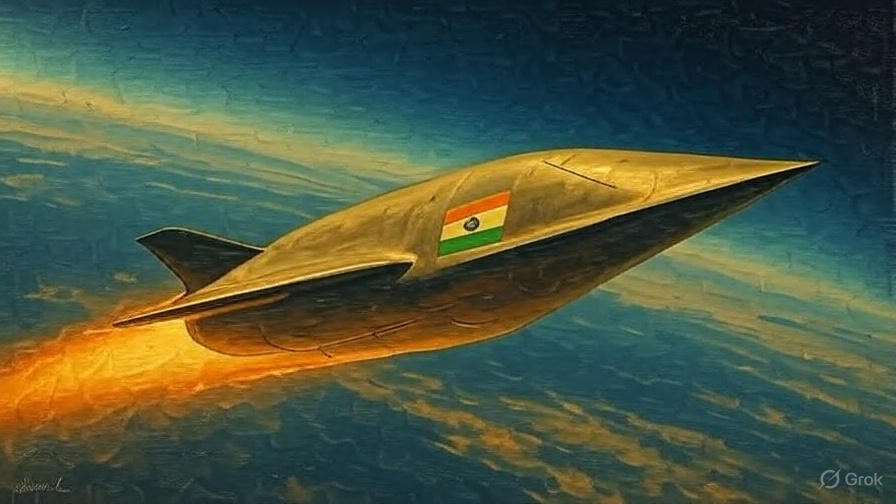India’s Hypersonic Missile Dhvani: 7 Facts You Must Know
Introduction
India is on the verge of a groundbreaking defense milestone. The Defence Research and Development Organisation (DRDO) is preparing to test Dhvani, India’s newest hypersonic missile, by the end of 2025. Designed to exceed Mach 5 (over 7,400 km/h), Dhvani represents a leap in missile technology, combining speed, precision, and maneuverability to enhance India’s strategic deterrence.
A recent tweet from @IndianTechGuide highlighted this development, showing a conceptual image of the missile and generating widespread discussion on India’s technological capabilities.
🚨 India will test its new hypersonic missile, Dhvani, designed to fly at over Mach 5 (more than 7,400 km/h), by the end of this year. pic.twitter.com/WhfvCegZBo
— Indian Tech & Infra (@IndianTechGuide) October 3, 2025
1. What is Dhvani?
Dhvani is a hypersonic glide vehicle (HGV) capable of traveling five times the speed of sound or faster. Unlike traditional missiles, it uses advanced aerodynamics and unpowered gliding to evade interception, making it a formidable weapon in modern warfare. Its estimated range is 6,000–10,000 kilometers, targeting both land and maritime assets with high precision.
2. Development and Technical Specifications
- Developer: DRDO
- Foundation: Based on the Hypersonic Technology Demonstrator Vehicle (HSTDV)
- Propulsion: Air-breathing scramjet engine for sustained hypersonic flight
- Heat Resistance: Ultra-high-temperature ceramics withstand 2,000–3,000°C during reentry
- Flight Mode: Two-stage system – rocket booster launch followed by hypersonic glide
- Maneuverability: Sharp mid-flight adjustments for evasion of missile defense systems
Compared to the BrahMos missile (Mach 2.8–3), Dhvani offers more than double the speed and advanced evasion, making it a strategic game-changer.
3. Test Timeline and Milestones
- Full-scale trial: Late 2025
- Induction into Armed Forces: Expected between 2029–2030
- Future Projects: Dhvani could evolve under Project Vishnu to include Mach 8 hypersonic cruise missiles
Challenges remain in thermal stress management and targeting accuracy, but recent subsystem tests suggest that DRDO is on track for a successful trial.
4. Strategic Significance
Dhvani positions India among an elite club of nations with operational hypersonic weapons: the USA, Russia, and China. Its deployment strengthens strategic deterrence in the Indo-Pacific region, particularly amid China-India tensions.
Additionally, Dhvani advances Atmanirbhar Bharat by promoting indigenous defense innovation, reducing reliance on foreign technology, and enhancing national security.
5. Global Context
Worldwide, hypersonic technology is a priority for modern militaries:
- Russia: Avangard
- China: DF-17
- USA: Conventional Prompt Strike
India’s entry with Dhvani could influence arms control discussions and future international collaborations in missile technology.
6. Advantages Over Existing Systems
- Speed: Exceeds Mach 5, faster than most cruise missiles
- Evasion: Glide trajectory enables low-altitude, unpredictable flight
- Range: Targets strategic land and maritime assets
- Self-reliance: Fully developed by DRDO under Atmanirbhar Bharat
7. Future Prospects
- Longer-range variants
- Integration with Project Vishnu for Mach 8 missiles
- Strengthening India’s position in global aerospace and defense technology
- Enhanced deterrence in regional and global security dynamics
FAQs
Q1. What is a hypersonic missile?
A hypersonic missile travels at Mach 5 or higher, combining speed and maneuverability to evade defenses.
Q2. How fast is Dhvani?
It exceeds 7,400 km/h (Mach 5), more than double the speed of the BrahMos missile.
Q3. When will Dhvani be tested?
A full-scale flight trial is expected by late 2025.
Q4. Who develops Dhvani?
The Defence Research and Development Organisation (DRDO) leads the project.
Q5. Why is Dhvani strategically important?
It strengthens India’s defense deterrence, advances indigenous technology, and positions India among global hypersonic nations.
Conclusion
India’s upcoming Dhvani missile test marks a transformative moment for national defense and technological progress. By combining speed, stealth, and precision, Dhvani will not only enhance India’s strategic deterrence but also signal its emergence as a leader in hypersonic technology. As global powers accelerate hypersonic development, India’s success could influence regional power dynamics and reshape future military strategy.
This milestone is more than a missile test—it is a statement of India’s self-reliance, innovation, and strategic foresight. Observers worldwide will watch closely, understanding that Dhvani represents both defense capability and national pride in the age of high-speed warfare.


0 comments